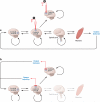The science of neural interface systems
- PMID: 19400719
- PMCID: PMC2921719
- DOI: 10.1146/annurev.neuro.051508.135241
The science of neural interface systems
Abstract
The ultimate goal of neural interface research is to create links between the nervous system and the outside world either by stimulating or by recording from neural tissue to treat or assist people with sensory, motor, or other disabilities of neural function. Although electrical stimulation systems have already reached widespread clinical application, neural interfaces that record neural signals to decipher movement intentions are only now beginning to develop into clinically viable systems to help paralyzed people. We begin by reviewing state-of-the-art research and early-stage clinical recording systems and focus on systems that record single-unit action potentials. We then address the potential for neural interface research to enhance basic scientific understanding of brain function by offering unique insights in neural coding and representation, plasticity, brain-behavior relations, and the neurobiology of disease. Finally, we discuss technical and scientific challenges faced by these systems before they are widely adopted by severely motor-disabled patients.
Figures



References
-
- Andersen RA, Buneo CA. Intentional maps in posterior parietal cortex. Annu. Rev. Neurosci. 2002;25:189–220. - PubMed
-
- Arle JE, Alterman RL. Surgical options in Parkinson's disease. Med. Clin. North. Am. 1999;83:483–98. vii. - PubMed
-
- Ashe J, Georgopoulos AP. Movement parameters and neural activity in motor cortex and area 5. Cereb. Cortex. 1994;6:590–600. - PubMed
-
- Barbieri R, Frank LM, Nguyen DP, Quirk MC, Solo V, et al. A Bayesian decoding algorithm for analysis of information encoding in neural ensembles. Conf. Proc. IEEE Eng. Med. Biol. Soc. 2004a;6:4483–86. - PubMed
-
- Barbieri R, Frank LM, Nguyen DP, Quirk MC, Solo V, et al. Dynamic analyses of information encoding in neural ensembles. Neural. Comput. 2004b;16:277–307. - PubMed
Publication types
MeSH terms
Grants and funding
LinkOut - more resources
Full Text Sources
Other Literature Sources
Medical

